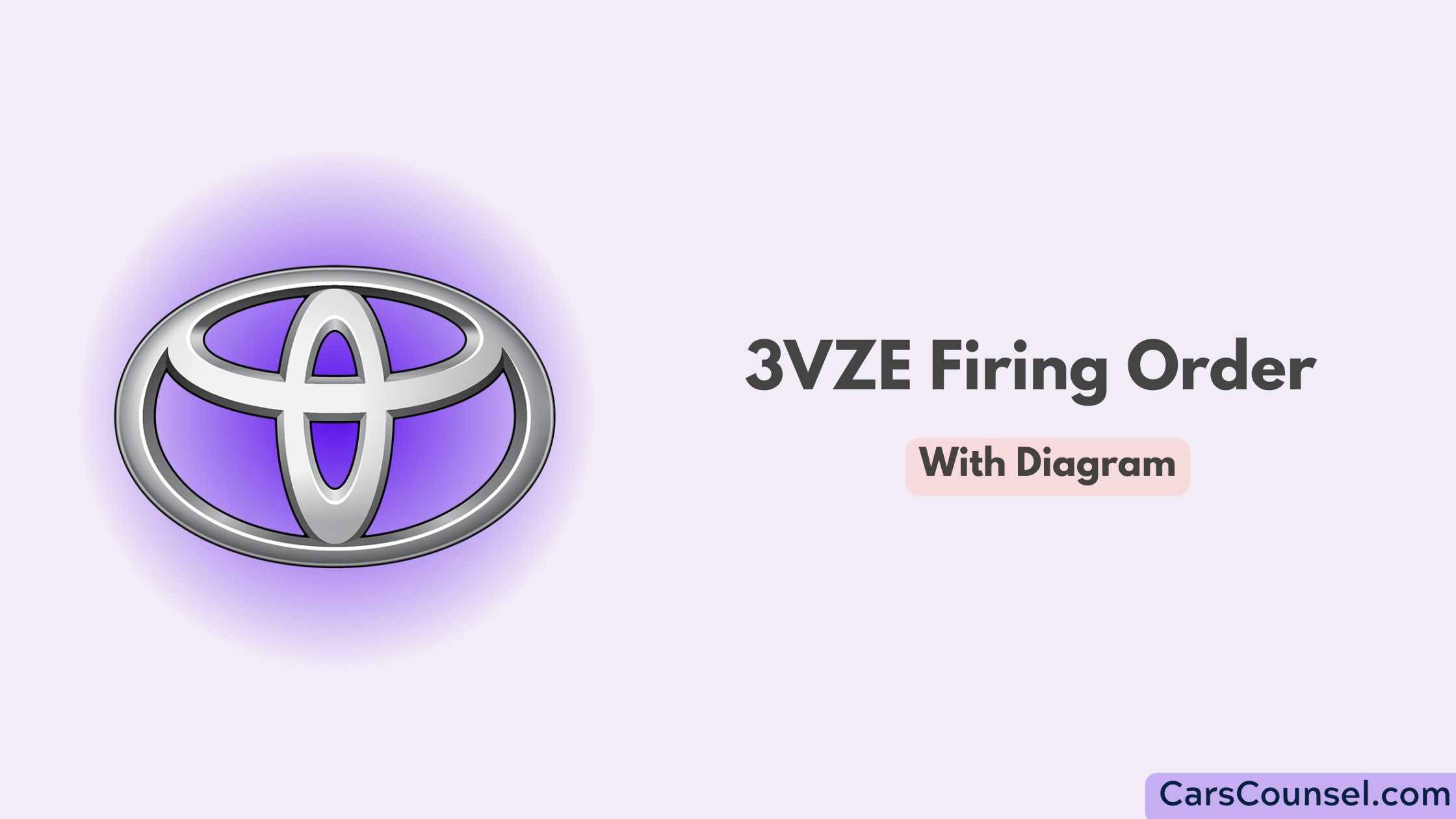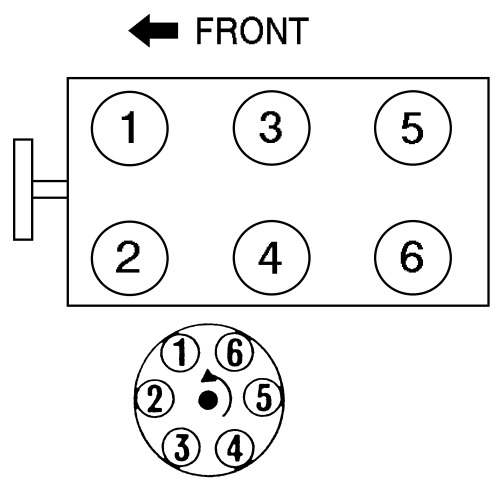The Toyota 3VZE engine is a 3.0-liter V6 engine that was widely used in various Toyota vehicles, including the 4Runner and Pickup trucks, during the late 1980s and early 1990s. Known for its durability and reliability, the 3VZE remains a popular engine among Toyota enthusiasts.
A crucial part of maintaining and repairing this engine is understanding its firing order.
In this guide, we’ll explore the 3VZE firing order, its importance, and how it works. Whether you’re an experienced mechanic or just getting started with automotive maintenance, this article will break down everything you need to know in a straightforward and conversational tone.

Quick Navigation
The 3VZE Firing Order
The firing order for the Toyota 3VZE engine is: 1-2-3-4-5-6

How the Firing Order Works
- Cylinder 1 Fires First: The ignition sequence begins with the frontmost cylinder on Bank 1.
- Cylinder 2 Fires Next: The combustion moves to the frontmost cylinder on Bank 2.
- Cylinder 3 Fires Third: Ignition returns to Bank 1, moving to the middle cylinder.
- Cylinder 4 Fires Fourth: The second cylinder on Bank 2 fires.
- Cylinder 5 Fires Fifth: The rearmost cylinder on Bank 1 ignites.
- Cylinder 6 Fires Last: The sequence ends with the rearmost cylinder on Bank 2 before repeating.
This sequential firing order alternates between the two banks, ensuring balanced engine operation.
What Is a Firing Order?
The firing order is the specific sequence in which the spark plugs ignite the air-fuel mixture in an engine’s cylinders. This sequence ensures the engine operates smoothly and efficiently by timing the combustion process perfectly.
Why Is the Firing Order Important?
- Smooth Engine Operation: The correct sequence minimizes vibrations and allows the engine to run smoothly.
- Optimal Performance: Proper timing maximizes power output and fuel efficiency.
- Engine Longevity: Balanced combustion reduces wear and tear on internal components.
- Preventing Misfires: Ensures each cylinder fires at the correct time, avoiding performance issues.
Overview of the 3VZE Engine
The 3VZE is a 3.0-liter V6 engine featuring an overhead camshaft design with a single camshaft per cylinder bank. Its V6 configuration means the engine has six cylinders arranged in two banks of three, angled in a “V” shape.
Cylinder Layout
To understand the firing order, it’s essential to know how the cylinders are numbered:
- Bank 1 (driver’s side in left-hand-drive vehicles): Cylinders 1, 3, and 5.
- Bank 2 (passenger side): Cylinders 2, 4, and 6.
Cylinders are numbered from front to back:
- Cylinder 1 is the frontmost cylinder on Bank 1.
- Cylinder 2 is the frontmost cylinder on Bank 2.
Why the 1-2-3-4-5-6 Firing Order Works
The 1-2-3-4-5-6 firing order is specifically designed to suit the V6 configuration of the 3VZE engine. Here’s why it’s effective:
- Balanced Combustion: Alternating between banks reduces stress on the crankshaft and maintains smooth operation.
- Reduced Vibrations: The sequence minimizes engine vibrations by distributing the firing events evenly across the cylinders.
- Efficiency: A consistent combustion pattern improves airflow and fuel combustion, enhancing overall efficiency.
Identifying the Firing Order
If you’re working on the 3VZE engine, confirming the firing order is critical for troubleshooting or replacing ignition components. Here’s how to identify it:
1. Consult the Owner’s Manual
The owner’s manual provides engine specifications, including the firing order and cylinder numbering.
2. Inspect the Engine Block
Cylinder numbers are often stamped on the intake manifold or near the spark plugs.
3. Use a Service Manual
Professional repair manuals include diagrams and detailed explanations of the engine’s layout and firing sequence.
Common Issues Related to Firing Order
An incorrect firing order can cause various engine performance problems. If the ignition sequence is disrupted, you might notice these symptoms:
Symptoms of Incorrect Firing Order
- Engine Misfires: Cylinders fail to ignite at the correct time, causing uneven power delivery.
- Rough Idling: The engine feels unstable or vibrates excessively at idle.
- Loss of Power: Acceleration is sluggish or inconsistent.
- Unusual Noises: Knocking or backfiring sounds can indicate irregular firing.
- Check Engine Light: The engine control module (ECM) may detect misfires and trigger a warning.
Causes of Firing Order Issues
- Misconnected Spark Plug Wires: Incorrectly routed spark plug wires can disrupt the firing sequence.
- Faulty Ignition Components: Damaged spark plugs, ignition coils, or distributors can affect the firing order.
- Timing Problems: A misaligned timing belt or chain can cause the engine’s firing sequence to fall out of sync.
Diagnosing and Fixing Firing Order Problems
Diagnostic Steps
- Check Spark Plug Connections: Ensure each spark plug wire is routed to the correct cylinder based on the firing order.
- Inspect Ignition Components: Examine spark plugs, ignition coils, and wiring for wear or damage.
- Verify Timing Alignment: Use a timing light to check the alignment of the timing belt or chain.
- Scan for Error Codes: Use an OBD-II scanner to detect misfire-related error codes.
Fixing Common Problems
- Reconnect Spark Plug Wires: Confirm wires are connected in the correct 1-2-3-4-5-6 sequence.
- Replace Faulty Components: Replace worn or damaged spark plugs, ignition coils, or distributors.
- Adjust Timing: Realign the timing belt or chain to restore proper synchronization.
Preventative Maintenance for the Firing Order
Maintaining the correct firing order is essential for the 3VZE engine’s longevity and performance. Follow these preventative measures to avoid firing order issues:
Regular Inspections
- Check spark plugs, ignition wires, and distributors during routine maintenance.
- Look for loose connections, corrosion, or wear on ignition components.
Replace Components as Needed
- Replace spark plugs and ignition wires at Toyota’s recommended intervals to maintain consistent ignition.
- Use high-quality parts to ensure reliability and compatibility.
Timing Belt Maintenance
- Inspect the timing belt regularly for signs of wear or damage.
- Replace the timing belt according to the manufacturer’s maintenance schedule.
FAQs About the 3VZE Firing Order
Can I Change the Firing Order?
No, the firing order is determined by the engine’s design and crankshaft configuration. Altering it would require significant engineering modifications.
What Happens If the Firing Order Is Incorrect?
An incorrect firing order can lead to misfires, rough idling, power loss, and potential damage to engine components.
Is the Firing Order the Same for All V6 Engines?
No, firing orders can vary depending on the engine’s design and configuration. The 3VZE specifically uses the 1-2-3-4-5-6 sequence.
How Can I Verify the Firing Order?
Refer to the owner’s manual, service manuals, or cylinder numbering on the engine block. Use a timing light to confirm ignition timing.
Engines with Similar Firing Orders
- 2009 Toyota Rav4 Firing Order
- 1HZ Firing Order
- 4AGE Firing Order
- Mark X Firing Order
- 2004 Toyota Camry Firing Order
Conclusion
The 1-2-3-4-5-6 firing order is crucial to the Toyota 3VZE engine’s operation. It ensures smooth performance, balanced power delivery, and optimal efficiency. Understanding and maintaining this firing order is essential for anyone working on or maintaining a vehicle with a 3VZE engine.
By following proper maintenance practices, diagnosing issues early, and adhering to Toyota’s guidelines, you can keep your 3VZE engine running reliably for years to come. Whether you’re an experienced mechanic or a Toyota enthusiast, mastering the firing order is a key step in preserving this legendary engine’s performance.

